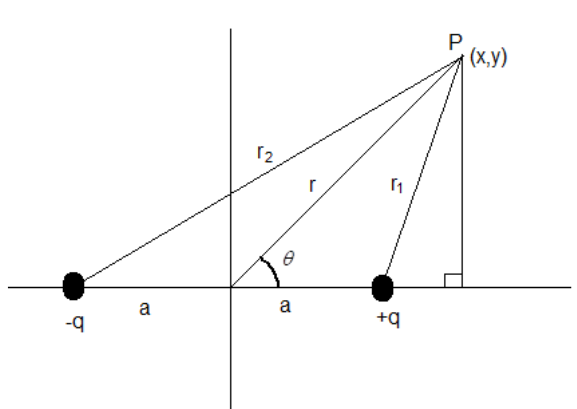Derive an expression for electric potential at point due to an electric dipole.
Discuss the special cases.
Hint: An electric dipole consists of two charges that are equal in magnitude (q) but opposite in polarity. (i.e. one is a positive charge and other is a negative charge). The two charges are separated by a distance of 2a.
Formula used: V
if x is very much small.
Complete step by step answer:
An electric dipole consists of a pair of charges that have the same magnitude \((q)\) but are opposite in nature. (i.e. one is a positive charge and other is a negative charge). The two charges are spaced apart by a distance of \(2a\). An electric dipole is characterized by a property known as the dipole moment, represented as \(P = 2qa\). Below is an illustration of an electric dipole.

Let an electric dipole with charges +q and –q lie on x-axis with the origin as the midpoint of the dipole.
Consider a point P at the coordinates (x,y). The distance of the point from origin be r making an angle θ with positive x-axis.

Electric potential due to a charge q at a point, which is at a distance r from the charge is given as
Where V is the potential due to the charge and K is permittivity of free space. Now, the electric potential at point P will be due two charges (+q and -q).
Let the potential due to charge +q be
Let the potential due to charge -q be
Let the total electric potential due to both the charges be V.
Since, electric potential is a scalar quantity,
If you see the given figure,
………………(i).
Since, is right-angled triangle,
Substitute the value of
in equation (i).
Therefore,
/And ………. (ii).
Is also a right-angled triangle. Therefore,
Substitute the value of /in equation (ii).
Therefore,
This implies that
…….(iii)
Consider the expression
open up the brackets.
…………… (1)
But
Therefore, expression (1) can be written as
Since r>>>>a,
From the figure we know,
Substitute the value of x in the above equation.
Therefore,
Take
as a common term.
…….(2).
Here,
is a very much small value because r>>>>a.Any term
if x is a very much small value or almost equal to zero.
Let us use the same concept in equation (2).
Therefore,
Hence, we get that
Therefore,
and
Thence we can write equation (iii) as
We know that 2qa=P.
……..(iv).
Therefore, the electric potential due to an electric dipole at a given point is equal to
Special cases:
(i) When the given point is on the axial line of the dipole (i.e.
).
Substitute
in equation (iv).
Therefore,
We know
Hence,
(ii) When the given point is on the equatorial axis of the dipole (i.e.
)
Substitute
in equation (iv).
Therefore,
We know
Hence,
When a point lies on the equatorial axis, the electric potential at that point becomes zero. You might question why
must be significantly larger than
.
Note:
This condition is justified because the concept of a dipole is essential in understanding molecules, which often exist as dipoles. For instance, in a water molecule, the bond between the oxygen and hydrogen atoms creates a dipole moment. The distance between these atoms is very small and can be considered negligible compared to the distance
from the midpoint of the dipole.


